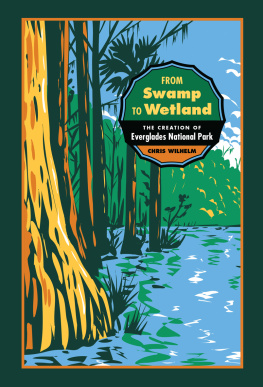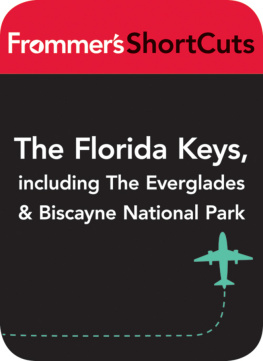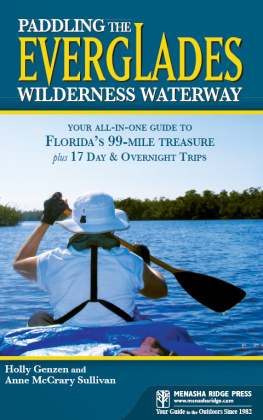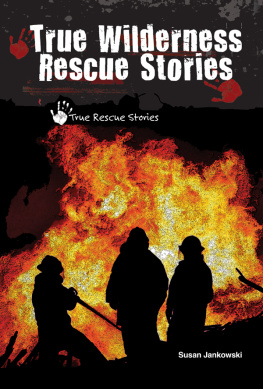THE VOICES
Oron Sonny Bass grew up in South Florida where the mangroves were an endless source of discovery and adventure. He fished, explored, learned, and ultimately made a career of the wild outdoors. Recently retired from his career in Everglades National Park, his memories of the mangroves span decades. He was interviewed in his office on Research Road.
John and Donna Buckley, following a career in canoe livery in Michigan, spent thirty-five winters (NovemberMarch) on a houseboat in the Everglades mangroves. They assisted with research, search and rescue, paddler assistance, and special projects of the park. They now spend summers volunteering in a remote area of Isle Royale National Park in Lake Superior. They told their story in conversations at Roberts River Chickee, North River Chickee, and on their on their houseboat, Swamp Lily II, near Tarpon Bay.
Tom Buttle first experienced the wilderness of Canada as a teenager. His parents would drop him off to spend a month alone in the forest. He now works as a seasonal volunteer in Everglades National Park, always arriving with a kayak in anticipation of solitary paddling and camping in the mangroves. He spoke of his kayaking adventures in his seasonal home in the park on Pine Island.
JohnBob Carlos traces the evolution of his relationship with the natural world of South Florida and notes how his Cuban heritage influences his interactions with the natural world, embracing both ecological and spiritual values. He makes a passionate plea for preservation. He was interviewed on the lower deck of Smallwood Store in Chokoloskee, Florida. (www.johnbobcarlos.com)
Roger Hammer is well-known for his guidebooks and books about wildflowers and botanical features of South Florida. He has spent countless hours, days, and weeks in the mangrove wilderness for a variety of overlapping purposes including plant study, fishing, and solitude. His story is constructed from interviews at his home in Homestead, Florida, and at Coe Visitor Center in Everglades National Park.
Rick Horton, teacher, carpenter, and commercial diver, now explores the mangrove waterways of southwest Florida. He prefers the edges, where he can more closely observe mangrove communities as they have weathered the passage of time and storm. He particularly notes evidence of human habitation, from early Calusa potsherds and shell mounds to remains of more recent pioneer settlement. Rick shared his stories on the porch of Kapok Cottage, the home he built in LaBelle, Florida.
Leon Howell, a native of South Florida, an outdoorsman since childhood, and a self-professed science and nature nut, has always chosen work that would get him outside. Following a twenty-year career in the Coast Guard and a second career as charter boat captain, he now revels in his role as interpreter in Everglades National Park. He was interviewed at his home in Homestead, Florida.
Bill Leonard, formerly a professor and faculty advisor to the Whitewater Canoe School at Georgia State, divided his time in retirement between Maine and South Florida. As a member of the Happy Hoofers chapter of Florida Trails, he spent many years paddling in Everglades National Park. He talked with pleasure of his adventures canoeing and clearing trails and also reminisced about solo trips out to single chickees in the mangrove wilderness. Bill was interviewed at a picnic table under a tree on his Maine farm.
John Lewis, having owned an outdoor store in Traverse City, Michigan, has spent many summers at the Ivey House (iveyhouse.com) leading kayak tours out of Everglades City and on the Turner River. In the areas where he paddles, he especially appreciates the diversity of bird life and vegetation and life in the water itself, mixing under the mangroves. He shares this appreciation with the paddlers on his tours. In the summertime he heads up north, often guiding kayak trips along the coast of Maine. We interviewed John at Ivey House in Everglades City after he returned from a morning kayak tour.
Ralph Miele (19202017) flew transport planes in the Pacific during World War II and became the first ranger pilot in the National Park Service. He was initially hired at Everglades National Park in 1952 to work in the fire control tower on Pine Island, but within a few years he was flying for the parktransporting fire control personnel, law enforcement rangers, researchers, politicians, and journalists. He had a birds-eye view of the complex mangrove estuaries and understood their ecological value. He retired from the Park Service in 1980. He was interviewed in Everglades National Park and at his home on Key Largo.
Constance Mier, a retired professor of exercise physiology at Barry University, has published articles in Sea Kayaker on nutrition and on aging, and she won the Fine Arts Award for her entry in the 2015 Audubon Photography Contest. She blogs regularly about her experiences photographing from a canoe. Her interview took place amid the exercise equipment at the lab at Barry University. (www.constancemierphotography.com)
Toby Nipper retired from Florida Power and Light after thirtynine years of service. He has participated in paddling races in Michigan and Missouri. As a WaterTribe member, he has been a contestant the Florida Challenge, a race from Naples to Key Largo, and also in the Ultimate Florida Challenge all the way around the state. With a friend, he has documented a summer thrupaddle of the Wilderness Waterway (http://www.youtube.com/watch?V=urOXNAjku0Q). Toby was interviewed at Gulf Coast Visitor Center in Everglades City just before putting his bimini up and paddling out into Chokoloskee Bay.
Vivian Oliva, born in Cuba, has been fishing since moving to Miami as a child. Originally working with a fishing guide in Biscayne Bay, she discovered the waters of Everglades National Park and now focuses her fishing out of Chockoloskee Bay and the Ten Thousand Islands, angling for snook, triple tail, and mangrove snapper in the bays and among the mangrove islands. She blogs about her adventures (beachcamper.glogspot.com). Vivian was interviewed at her home via Skype.
Susan Reece worked as an Everglades interpretive ranger and then a supervisory ranger overseeing activities at Gulf Coast and Shark Valley from 20012015. At Gulf Coast, near Everglades City, she advised paddlers as they planned itineraries and prepared to head out into the mangrove wilderness. She also oversaw management of the extensive mangrove areas north of the Broad River in Everglades National Park. Currently, she is chief of interpretation at Pictured Rocks National Lakeshore in Michigan.
Ann Rougle, on the water since her Annapolis, Maryland, childhood, now has sailing adventures in a Folbot in Everglades National Park. She values solitude and likes nothing better than to launch into magnificent cold fronts. She spends summers traveling and then heads back to the Everglades in the winter. If there are past lives, she says, one of mine was surely as a Calusa. This is my place. Under the shelter at West Lake in the Everglades, she spoke of her adventures. She keeps a journal and has shared some of her writing for this narrative.
Margo Schwadron, a National Park Service archaeologist since 1991, specializes in studying the relationship between environment and community, with particular focus on the prehistoric settlements in the Ten Thousand Islands. Her investigations have included unique shell ring sites, large shell islands, and the Turner River mounds. She has submitted a successful application to have the sites named collectively The Ten Thousand Islands Archaeological District and listed on the National Register of Historic Places. We interviewed Margo on the dock at Gulf Coast Visitor Center, during the course of boat travel and a trek on the Turner River Mounds, and at the Havana Cafe in Chokoloskee.







